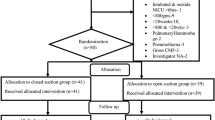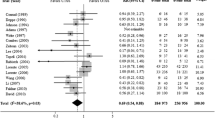Abstract
Objectives
To compare the difference in efficacy of closed tracheal suction system (CTSS) to open tracheal suction system (OTSS) in reducing incidence of ventilator associated pneumonia (VAP). Also to evaluate their efficacy in stabilizing cardio-respiratory parameters, reducing mortality and duration of intubation.
Methods
This study was a single centre, parallel group, open label, randomized controlled study with an equal allocation (1:1) in pediatric patients requiring mechanical ventilation. A specific suction system of CTSS or OTSS was assigned to the two groups based on randomization. All the demographic, clinical, laboratory parameters and treatment outcomes were noted in the preformed sheet.
Results
Total 116 eligible pediatric ventilated patients were studied. Total incidence of VAP was 9 (7.75%) of which 3 occurred in open and 6 in closed suction group. Rate of VAP was similar among both the groups with RR 2.11 (95% CI 0.50–8.9). However, significant number of infection-related ventilator associated condition (IVAC) were found in CTSS (17) compared to OTSS (6) group with RR 3.5 (95% CI 1.3–9.9). SpO2 was better maintained in the CTSS group post-suction (p = 0.001). Incidence of mortality and intubation days were similar between both groups.
Conclusions
Incidence of VAP was similar between open and closed suction groups.



Similar content being viewed by others
References
Schults JA, Long DA, Mitchell ML, et al. Adverse events and practice variability associated with paediatric endotracheal suction: an observational study. Aust Crit Care. 2020;33:350–7.
Evans J, Syddall S, Butt W, Kinney S. Comparison of open and closed suction on safety, efficacy and nursing time in a paediatric intensive care unit. Aust Crit Care. 2014;27:70–4.
Briassoulis P, Briassoulis G, Christakou E, et al. Active surveillance of healthcare-associated infections in pediatric intensive care units: multicenter ECDC HAI-net ICU protocol (v2. 2) implementation, antimicrobial resistance and challenges. Pediatr Infect Dis J. 2021;40:231–7.
Kuriyama A, Umakoshi N, Fujinaga J, Takada T. Impact of closed versus open tracheal suctioning systems for mechanically ventilated adults: a systematic review and meta-analysis. Intensive Care Med. 2015;41:402–11.
Tume LN, Baines PB, Guerrero R, et al. Pilot study comparing closed versus open tracheal suctioning in postoperative neonates and infants with complex congenital heart disease. Pediatr Crit Care Med. 2017;18:647–54.
Ardehali SH, Fatemi A, Rezaei SF, Forouzanfar MM, Zolghadr Z. The effects of open and closed suction methods on occurrence of ventilator associated pneumonia; a comparative study. Arch Acad Emerg Med. 2020;8:e8.
Klompas M, Branson R, Eichenwald EC, et al. Strategies to prevent ventilator-associated pneumonia in acute care hospitals: 2014 update. Infect Control Hospital Epidemiol. 2014;35:915–36.
Arthur N, Kaur I, Carey AJ. Evaluation of the applicability of the current CDC pediatric ventilator-associated events (PedVAE) surveillance definition in the neonatal intensive care unit population. BMC Pediatr. 2022;22:185.
David D, Samuel P, David T, Keshava SN, Irodi A, Peter JV. An open-labelled randomized controlled trial comparing costs and clinical outcomes of open endotracheal suctioning with closed endotracheal suctioning in mechanically ventilated medical intensive care patients. J Crit Care. 2011;26:482–8.
Fakhar HRE, Rezaei K, Kohestani HR. Effect of closed endotracheal suction on incidence of ventilator-associated pneumonia. Sci J Kurdistan Univ Med Sci. 2010;15:79–87.
Subirana M, Solà I, Benito S. Closed tracheal suction systems versus open tracheal suction systems for mechanically ventilated adult patients. Anesthesia Analgesia. 2008;106:1326.
Morrow BM, Argent AC. A comprehensive review of pediatric endotracheal suctioning: effects, indications, and clinical practice. Pediatr Crit Care Med. 2008;9:465–77.
Niel-Weise BS, Snoeren RL, Van den Broek PJ. Policies for endotracheal suctioning of patients receiving mechanical ventilation: a systematic review of randomized controlled trials. Infect Control Hosp Epidemiol. 2007;28:531–6.
Topeli A, Harmanci A, Cetinkaya Y, Akdeniz S, Unal S. Comparison of the effect of closed versus open endotracheal suction systems on the development of ventilator-associated pneumonia. J Hosp Infect. 2004;58:14–9.
Subirana M, Solà I, Benito S. Closed tracheal suction systems versus open tracheal suction systems for mechanically ventilated adult patients. Cochrane Database Syst Rev. 2007;4:CD004581.
Afshari A, Safari M, Oshvandi K, Soltanian AR. The effect of the open and closed system suctions on cardiopulmonary parameters: time and costs in patients under mechanical ventilation. Nurs Midwifery Stud. 2014;3:e14097.
Lasocki S, Lu Q, Sartorius A, Fouillat D, Remerand F, Rouby JJ. Open and closed-circuit endotracheal suctioning in acute lung injury: efficiency and effects on gas exchange. Anesthesiology. 2006;104:39–47.
Elmansoury A, Said H. Closed suction system versus open system. Eur Respir J. 2014;44:2548.
Acknowledgements
The authors are grateful for the cooperation of parents and the Narayana Hrudayalaya Multispeciality Hospital, Bangalore for providing the infrastructure. They are obliged to Prof. Devi Shetty for constant motivation to carry out this work. They offer sincere thanks to Seniors, Colleagues for their insightful discussion to complete this work.
Author information
Authors and Affiliations
Contributions
SSD, RA, HS, NKM: conceptualization; SSD, MS, AS, SP: data acquisition, data analysis, literature review and manuscript writing; HS, AS, MS: critical review of the manuscript. All the authors approved the final manuscript. SSD will act as guarantor of the study.
Corresponding author
Ethics declarations
Conflict of Interest
None.
Additional information
Publisher's Note
Springer Nature remains neutral with regard to jurisdictional claims in published maps and institutional affiliations.
Rights and permissions
Springer Nature or its licensor (e.g. a society or other partner) holds exclusive rights to this article under a publishing agreement with the author(s) or other rightsholder(s); author self-archiving of the accepted manuscript version of this article is solely governed by the terms of such publishing agreement and applicable law.
About this article
Cite this article
Dhal, S.S., Aggarwal, R., Sagar, H. et al. Open versus Closed Suctioning Among Mechanically Ventilated Pediatric Patients: A Randomised Control Trial. Indian J Pediatr (2024). https://doi.org/10.1007/s12098-024-05069-2
Received:
Accepted:
Published:
DOI: https://doi.org/10.1007/s12098-024-05069-2




